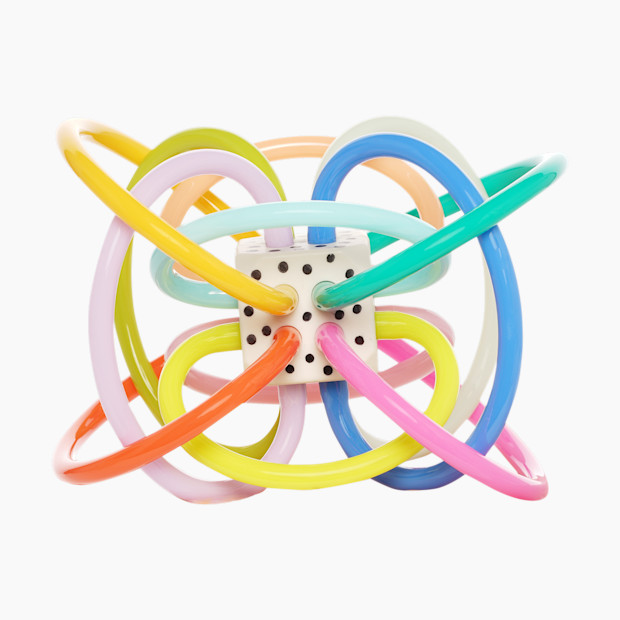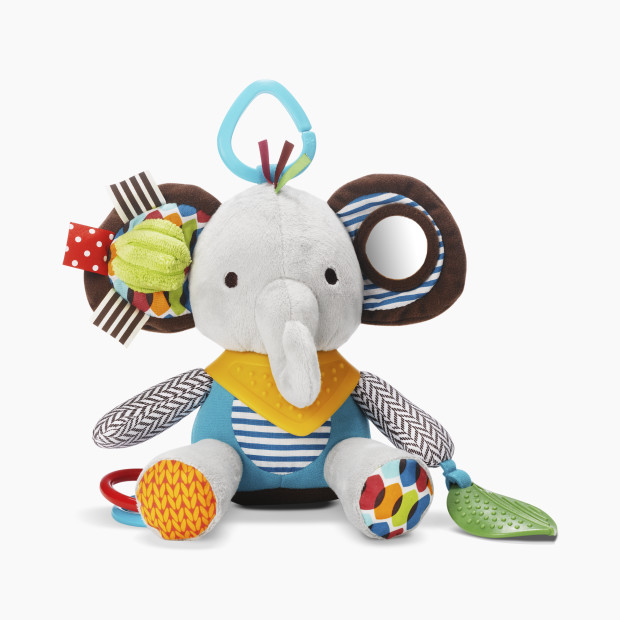
Your 11-Week-Old Baby
Your baby is discovering their body, and you may still be settling into yours. And cluster feeding may be happening…again.

In This Article
This week, baby is all about their hands: discovering them, using them and—as an actual developmental milestone—sticking them in their mouth. Dr. Chris Klunk, a board-certified neonatologist at Pediatrix Medical Group, talks about the importance of these hand-focused developments. And more milestones also means that cluster feeding might be happening again, and you can also expect the first dreaded sleep regression soon. (With the right preparation and awareness, it hopefully won’t be too bad.)
And while your baby is busy discovering their body, if you gave birth, you might be thinking about how your own body has evolved over the past year since pregnancy started. If you’re having feelings about “bouncing back,” we’ve got some grounding advice from ob-gyn Dr. Faith Ohuoba.
🚼 Baby’s Development
🙌 "Finding" Their Hands
Get ready to witness baby’s first lightbulb moment: realizing that their hands are actually part of their body that they have control over. It might seem like a strange thing to “discover,” but keep in mind that your baby wasn’t born with any sense of self-awareness—and this is the first step.
What does this milestone look like? "Babies 'finding' their hands means exactly what it sounds like," Dr. Klunk says. "'What are these things attached to me?!' They will stare at them and explore them, put them on their face and start to put them together or in their mouth. It’s truly as if they just realized they’re there."
It sounds a little weird and funny, but your baby is honestly just trying to figure out what all their hands can do and what they’re for.
This milestone appears right alongside a couple other hand-related developments (which we’ll talk about next) as the earliest stages of hand-eye coordination and fine motor skills.
🤭 Hand-to-Mouth Movements
As part of their hand discovery, your baby may be putting their fingers in their mouth more often these days. While previously it signaled a hunger cue, especially if they were sucking on their fingers, it’s now a more intentional method of self-discovery.
Babies learn best with their mouths (remember the rooting and sucking reflexes from the earliest newborn days?), so of course they’re going to learn all about their newly discovered hands by sticking them right inside their mouth.
These hand-to-mouth movements are just the first step for baby to learn about everything else in the same way. "This is a sign of developing hand-eye coordination and of things to come," Dr. Klunk says. He says that these hand-to-mouth movements are essential for babies to learn in order to self-feed and self-soothe in the (near) future.
Over the next several months, you’ll see them put all sorts of stuff in their mouth—toys, burp cloths, your hands—so be sure to keep an eye on them to prevent any choking hazards.
✊ Grasping
For the first couple of months, your baby was able to close their fist around your finger if you touched their palm. That was the palmar grasp reflex, and baby had no control over it. But now that those newborn reflexes are disappearing and baby is discovering their hands, they’ll start trying to grasp things on purpose in the coming weeks.
You may notice baby trying to wrap their fingers around your hand, your shirt, a toy, a blanket or anything else they can reach. They may not be able to firmly grasp and hold on just yet, but even just lightly wrapping their fingers around something is a good first step. With enough practice, pretty soon they’ll be able to actually keep hold of objects—a milestone that babies usually reach between four and six months old.
To encourage baby’s grasping skills, offer lightweight toys with narrow, baby-fist-sized handles. Too wide and they won’t be easy to grip; too heavy and they won’t be easy to lift. Things like rattles, teething toys and your own fingers are a great place to start.
💡Try This with Baby: Toy Reach
Those toys we just mentioned can help develop more than just grasping skills. By placing toys just slightly out of reach, you can encourage all of baby’s newly aquired hand-eye coordination skills.
Having a favorite toy just an inch or so away from their hand will inspire baby to reach out and try to grasp it, which, at just 11 weeks old, is more complicated than it sounds. Baby will use eye tracking, depth perception, hand discovery and grasping just to try to reach the toy—just goes to show how much they’ve learned in such a short time.
This game works great during tummy time or while baby’s is lying on their back, and you might even get a smile from your baby once they’ve successfully grabbed their toy.
💗 You, 11 Weeks After Baby
🪞 Body Image
If you gave birth, at nearly three months postpartum, you’re almost out of the “fourth trimester” phase. Your body has been through a lot of physical changes over the past twelve months, and it’s completely normal if you feel conflicted.
You can be proud of what it’s accomplished—growing and birthing a human being—while also feeling a little bit like a stranger in your own body. Things look and feel differently than they did pre-baby (and some parts may be working differently, too…looking at you, pelvic floor), and the pressure to “bounce back” can start to sneak in now that, according to traditional postpartum timelines, you’re technically all healed up.
But the truth is, your body went through a massive transformation—and complete healing takes time. “Your body literally expanded to accommodate a new growing baby, and that took nine months,” Dr. Faith, an ob-gyn, reminds us. “Your body will need time to get back to baseline—or even a new baseline. The myth of ‘bouncing back’ can place undue burden and body image stress on you.”
While it’s easier said than done, try not to feel like you have to go back to a “before” version of yourself. Instead of striving to bounce back, Dr. Faith encourages reframing this season as one of “developing new healthy habits,” especially as you have to split your time and energy between yourself and your new baby (and everything else).
“Assess your diet, activity, sleep hygiene, mental health and self-care routine,” Dr. Faith says. It’s not about pressure to get your pre-baby body back—it’s about small, sustainable choices that support who you are now. “Most importantly, give yourself and your body time. Embrace with grace the transformation and transition.”
And if you’re still living in your maternity clothes, that’s more than okay. Extending the life of your maternity clothes is practical, not to mention comfy, and that’s the vibe you deserve right now, no matter how you feel about your postpartum body.
Forcing yourself back into pre-pregnancy clothes before you're ready isn't a badge of honor, it’s a recipe for discomfort. So wear whatever makes you feel good. (And keep in mind that people out in the real world probably won’t actually be able to tell that you’re wearing maternity clothes.)
🧑🍼 Feeding Baby
🍼 Week 11 Feeding Guidelines
3–4 fluid ounces per feed, every 3–4 hours; 6–8 feedings per day for a total of 24–30 fluid ounces per day.
😩 Cluster Feeding (Again)
Just when you thought your baby’s feeding schedule was settled, cluster feeding may show up again. The three-month mark usually comes with a physical growth spurt, which means baby may need more frequent meals to keep up with everything.
Just like when we talked about this before way back in week four, remember that cluster feeding is totally normal and happens at a few different stages during baby’s first year (it may happen again when baby reaches six months old).
Those short, frequent feeds don’t necessarily mean your milk supply is low or that you need to swap to a different formula. It’s just a brief phase to support baby’s new developments, and it’ll hopefully only last a few days.
😴 Sleep
🛏️ Total Sleep: 12–16 Hours
Naps: 2–3 per day for 2–3 hours each
😩 Preparing for the First Sleep Regression
You may have established a regular nap schedule and are cherishing a good four to five hours of sleep stretches at night. But about a month from now, around four months old, many babies experience their first big sleep regression—a phase when baby’s sleep routine gets disrupted thanks to exciting new cognitive developments. It usually looks like baby having trouble falling asleep, staying asleep and maybe refusing naps.
But don’t panic just yet. While it’s true that sleep regressions are infamously a tougher stage for both babies and parents, you’ve still got a little bit of time to prepare (which is why we’re warning you now).
If you haven’t yet, now is a good time to start gently establishing a sleep routine. Don’t go whole hog on sleep training yet—waiting until after the sleep regression has passed will make it easier on everyone, and most pediatricians and infant sleep specialists advise waiting to sleep train until after baby is four months old anyway. Having a short, reliable ritual before naps and bedtime will give you at least one consistent element as baby’s sleep times inevitably shift during the regression.
❓Weekly How-To: Choose Toys
As your baby’s social skills and engagement abilities develop, they’ll get more and more interested in actually playing—responding when you talk or smile, reaching for toys and generally being more alert and interactive.
To help support your baby’s playtime, it’s important to make sure their toys are safe and developmentally appropriate. But what kind of toys actually make sense for an almost-three-month-old?
Babies this age don’t need much. Like we said above, focus on lightweight, easy-to-grasp toys that encourage baby’s early fine motor skills and hand-eye coordination. Sensory exploration is also huge at this stage, so toys with a variety of textures, patterns (especially high-contrast with black and white or saturated colors) and gentle sounds are perfect—bonus points if they have tags (babies love tags).
And for your own convenience and sanity, go for toys that are easy to clean. You know well by now that things like drool, spit up and blow outs happen often enough, and toys that can be wiped down or tossed in the washing machine mean you can get back to playing that much faster.
👀 Looking Ahead
Rolling over: You might notice baby attempting to roll from tummy to back in the coming weeks, especially during tummy time.
Lifting up onto elbows: Your baby will soon be strong enough to push up onto their forearms during tummy time as they build strength for rolling and (eventually) crawling.
🛍️ Panic Order

Lamaze
Garden Bug Wrist Rattle & Foot Finder Set

Manhattan Toy
Toy Winkel Rattle

Bright Starts
Soothers & Shakers 7-Piece Baby Toy Gift Set

Skip Hop
Bandana Buddies Elephant Stroller Toy

Kindred Bravely
Jane Nursing Pajama Set

Ember
Ember Mug 2
Expert Sources
Babylist content uses high-quality subject matter experts to provide accurate and reliable information to our users. Sources for this story include:
Dr. Faith Ohuoba, Houston-based ob-gyn
